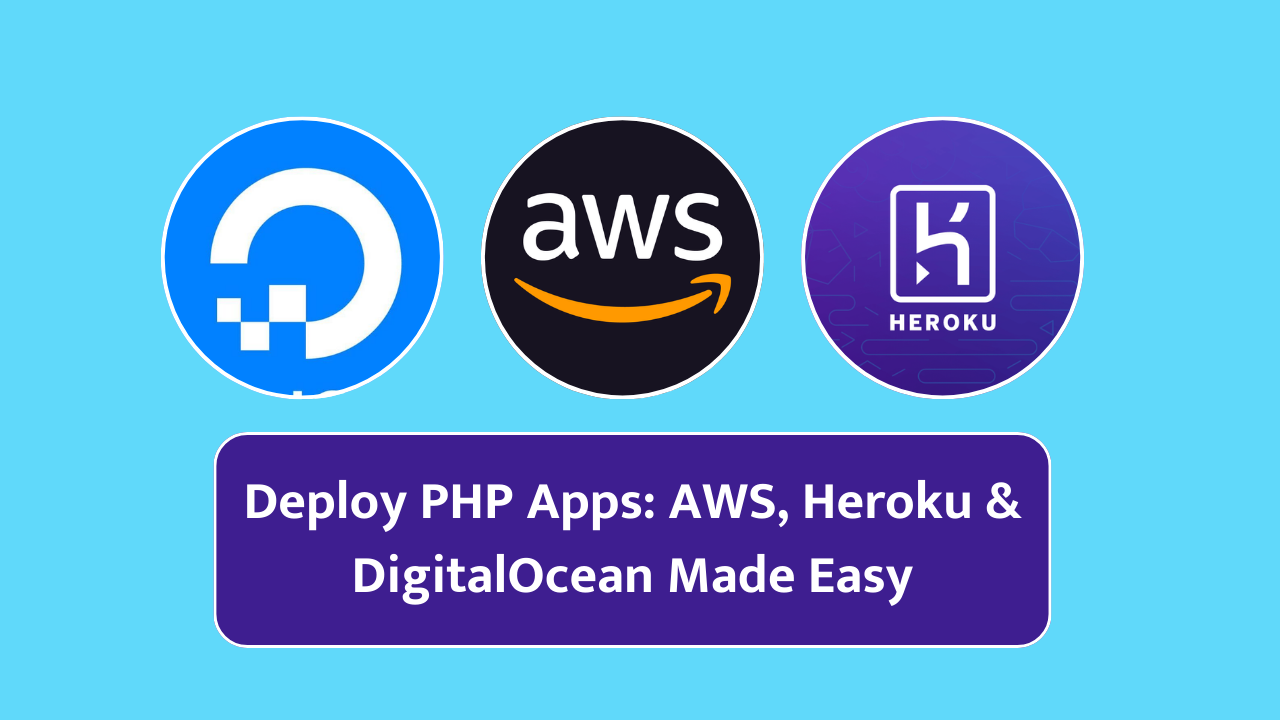How to Deploy PHP Applications on AWS, Heroku, and DigitalOcean
Deploying PHP applications is a crucial step in making your projects accessible to users. With numerous hosting options available, AWS, Heroku, and DigitalOcean are among the most popular platforms for deploying PHP applications. Each platform offers unique features and workflows, allowing you to choose the best fit for your requirements. In this guide, we will walk you through the steps to deploy PHP applications on AWS, Heroku, and DigitalOcean.
Deploying PHP Applications on AWS
Amazon Web Services (AWS) provides scalable and reliable cloud services. Elastic Beanstalk and EC2 are common choices for deploying PHP applications.
Step 1: Set Up an AWS Account
- Visit AWS and create an account.
- Log in to the AWS Management Console.
Step 2: Deploy with Elastic Beanstalk
Elastic Beanstalk simplifies deployment by managing servers, load balancers, and scaling.
- Install the Elastic Beanstalk CLI:
pip install awsebcli - Initialize Your Application: Navigate to your PHP project directory and run:
eb init- Select a region.
- Choose PHP as the platform.
- Create an Environment and Deploy:
eb create php-environmentElastic Beanstalk will provision resources and deploy your application.
Step 3: Access Your Application
Once deployed, AWS provides a URL to access your application. For custom domains, configure Route 53 and attach your domain to the Elastic Beanstalk environment.
Best Practices:
- Use RDS for databases instead of local storage.
- Enable auto-scaling to handle traffic surges.
- Secure your environment with IAM roles and HTTPS.
Deploying PHP Applications on Heroku
Heroku is a platform-as-a-service (PaaS) that simplifies app deployment with minimal configuration.
Step 1: Set Up Heroku CLI
- Install the Heroku CLI:
curl https://cli-assets.heroku.com/install.sh | sh - Log in to Heroku:
heroku login
Step 2: Prepare Your PHP Application
- Ensure your project has a
composer.jsonfile. - Add a
Procfileto specify the web server (e.g., Apache or Nginx):web: vendor/bin/heroku-php-apache2 public/
Step 3: Deploy Your Application
- Initialize a Git repository if you don’t have one:
git init - Create a Heroku app:
heroku create - Push your code to Heroku:
git add . git commit -m "Initial commit" git push heroku main
Step 4: Access Your Application
Heroku provides a public URL for your application. To use a custom domain, follow Heroku’s custom domain setup.
Best Practices:
- Use Heroku Add-ons for databases (e.g., PostgreSQL or ClearDB).
- Enable error logging with the
heroku logs --tailcommand. - Scale your application with
heroku ps:scale.
Deploying PHP Applications on DigitalOcean
DigitalOcean provides flexible cloud hosting solutions, including Droplets (virtual servers) and App Platform.
Option 1: Using Droplets
- Create a Droplet:
- Log in to DigitalOcean and create a new Droplet.
- Choose the LAMP stack (Linux, Apache, MySQL, PHP) for an out-of-the-box PHP environment.
- Connect to Your Droplet: Use SSH to access your Droplet:
ssh root@your_droplet_ip - Upload Your PHP Application: Use SCP or an FTP client to upload files:
scp -r /path/to/your/php/app root@your_droplet_ip:/var/www/html - Configure Apache/Nginx: Update the Apache virtual host configuration or create an Nginx server block to point to your PHP application.
- Access Your Application: Open your Droplet’s IP address in a browser. For custom domains, update your DNS records.
Option 2: Using DigitalOcean App Platform
- Create a New App:
- Log in to the DigitalOcean Control Panel.
- Select the App Platform and choose “Launch Your App.”
- Connect Your Repository: Link your GitHub or GitLab repository containing the PHP application.
- Configure the Build:
- Select the PHP runtime.
- Configure the build and deploy settings.
- Deploy and Access: DigitalOcean will build and deploy your application. It provides a default subdomain, which you can replace with a custom domain.
Best Practices:
- Use managed databases for better scalability.
- Secure your Droplet with firewalls and SSL certificates.
- Monitor resource usage using DigitalOcean Monitoring.
Comparing AWS, Heroku, and DigitalOcean
| Feature | AWS | Heroku | DigitalOcean |
|---|---|---|---|
| Ease of Use | Moderate | Easy | Moderate |
| Scalability | Excellent | Good | Excellent |
| Customizability | High | Limited | High |
| Cost | Pay-as-you-go | Free tier available | Affordable Droplets |
| Best For | Enterprise-grade apps | Rapid prototyping | Flexible deployments |
Conclusion
Deploying PHP applications on AWS, Heroku, and DigitalOcean can seem daunting at first, but each platform offers tools and features to streamline the process. AWS is ideal for large-scale and enterprise-level applications, Heroku is perfect for developers seeking simplicity and speed, and DigitalOcean provides flexibility for custom configurations. By following the steps outlined in this guide, you can confidently deploy your PHP applications and bring your projects to life.
ALSO READ : Create a Blog Website Using PHP: 100% Step-by-Step Guide



![Top Python Interview Topics: A Beginner’s Guide for Students [Latest 2025]](https://developer.thrend.in/wp-content/uploads/2025/11/ChatGPT-Image-Nov-18-2025-02_21_01-PM.png)